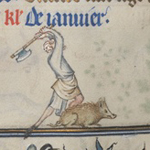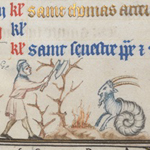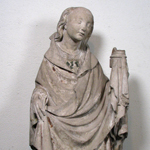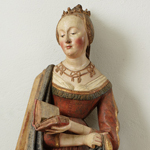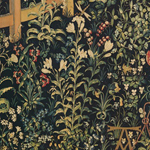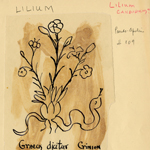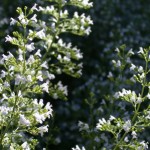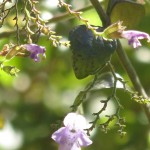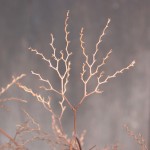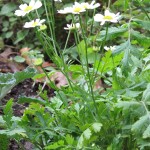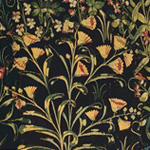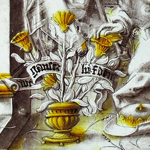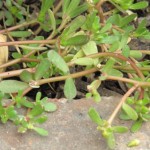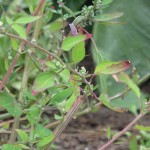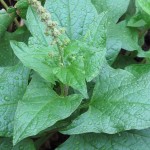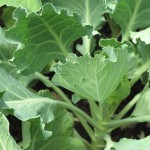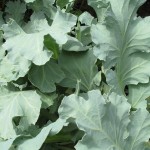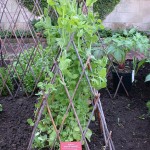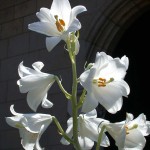Tuesday, December 21, 2010
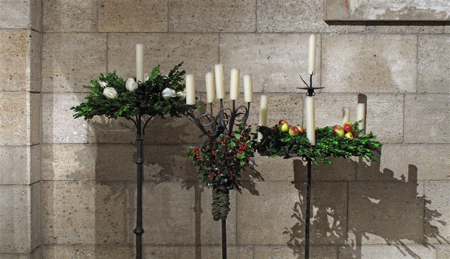
Above: The iron candelabra placed throughout the galleries of The Cloisters are decked with boxwood, ivy, apples, roses, and holly from mid-December until early January. This year’s decorations will be on view through Sunday, January 2. Photograph by Andrew Winslow.
WISHING YOU PEACE, PLENTY, AND EVERY GOOD THING IN THE COMING YEAR.??
???Deirdre Larkin and the staff of The Cloisters Museum & Gardens
Tags: apples, boxwood, holly, ivy, roses
Posted by Deirdre Larkin on Tuesday, December 21 at 4:11 pm | Comments (2)
Friday, December 10, 2010
The calendar pages of medieval Books of Hours were embellished with illuminations depicting the traditional labors or activities associated with the month. Above, two folios showing the activities for December, from the Psalter and Hours of Bonne of Luxembourg, Duchess of Normandy. The Cloisters Collection, 1969. (69.86). (See the Collection Database to learn more about this work of art.) In the detail shown in the center, a man prepares to deal the death stroke to a boar; the detail on the right shows a man cutting firewood with an ax. (The cutting and gathering of firewood is a minor labor, sometimes shown as a late autumn or early winter activity.)
Read more »
Tags: arches, boar, book of hours, firewood, garland, wreath
Posted by Deirdre Larkin on Friday, December 10 at 12:25 pm | Comments (0)
Friday, December 3, 2010
Above, from left to right: Saint Barbara (detail), mid-15th century, French, Gift of Mr. Edward G. Sparrow, 1950 (50.159); Detail of Saint Barbara from The Virgin Mary and Five Standing Saints above Predella Panels, 1440???46, The Cloisters Collection, 1937 (37.52.1); Saint Barbara (detail), ca. 1490, German, The Cloisters Collection, 1955 (55.166).
Although Saint Barbara is not mentioned in early martyrologies, hagiographies place the early Christian virgin and martyr in the third century A.D. According to The Golden Legend, a popular collection of saints’ lives dating to the thirteenth century, she was martyred on the fifth of December, during the reign of Emperor Maximianus and under the orders of Martianus, the prefect of her city of Heliopolis, in??Phoenicia. Veneration of Saint Barbara was common in both the eastern and western churches by the ninth century, and she remains a popular saint to this day, although her feast is widely celebrated on the fourth rather than the fifth of December. Read more »
Tags: Adonis, anise, Anthesteria, Barbarazweig, Barbarea, Barbarea vulgaris, barley, Eleusinian Mysteries, kykeon, Martianus, Maximianus, pomegranate, Provence, raisin, Saint Barbara, The Golden Legend, wheat, winter cress, yellow rocket
Posted by Deirdre Larkin on Friday, December 3 at 5:38 pm | Comments (4)
Monday, November 22, 2010
Above from left to right: Margaret Freeman in her office at The Cloisters in 1938; a large and lovely rendering of Lilium candidum prominently placed in the flowery field below the enclosure of the Unicorn in Captivity; tracing of a woodcut image illustrating the entry for the same species of lily, taken by Freeman from the herbal of Apuleius Platonicus, sometimes known as the Pseudo-Apuleius. The Latin subscription states that this lily was known to the Greeks as “Crinion.”
This is not the lily which today is and tomorrow is cast into the oven; it will blossom for ever.
???Saint Bernard of Clairvaux, Sermon 70 on the Song of Songs, III.6
Margaret B. Freeman was associated with The Metropolitan Museum of Art for fifty-two years, first as a lecturer at the old Cloisters in 1928, then as a curator, and eventually as director of The Cloisters in 1955, succeeding James Rorimer. Charged with the development of the gardens, Ms. Freeman was perhaps the single most important contributor to the list of medieval plants drawn from historical sources, which is still in use here. Read more »
Tags: Crinion, James Rorimer, Lilium candidum, lily, Margaret Freeman, Pseudo-Apuleius
Posted by Deirdre Larkin on Monday, November 22 at 3:54 pm | Comments (4)
Wednesday, November 17, 2010
The pretty, fragrant lesser calamint flourishes in all three of the enclosed gardens at The Cloisters. Each small shrub bears a host of delicate little flowers from late summer through frost. Above, from left to right: The lipped flowers of calamint are characteristic of members of the Labiatae, or mint, family; cold weather brings out the purplish cast in the flowers; calamint is beautiful even in winter, when the fine stems are bare.
The larger-flowered calamint, known as Calamintha grandiflora, is frequently grown in modern gardens, but the lesser calamint, Calamintha nepeta, is the calamint of the Middle Ages. Read more »
Tags: calamint, Calamintha grandiflora, Calamintha nepeta, Calamintha officinalis, Cuxa Garden, marjoram, nepitella, Satureja hortensis, Satureja montana, savory, White Cloud
Posted by Deirdre Larkin on Wednesday, November 17 at 11:46 am | Comments (1)
Friday, November 12, 2010
The common name of feverfew is derived from the Latin febrifuge. Botanists now place this member of the aster family in the genus Tanacetum, but feverfew was formerly known both as Chrysanthemum parthenium and Pyrethrum parthenium and may be listed as such in older sources. Above, left and center: Feverfew??growing in Bonnefont garden in November; right: the only feverfew plant depicted in the Unicorn Tapestries appears between the feet of the hunter poised to spear the quarry in The Unicorn Defends Itself.
Feverfew (Tanacetum parthenium) is a strongly aromatic herb in the aster family; it is closely related to costmary (Tanacetum balsamita) and to tansy (Tanacetum officinale), both of which also grow in Bonnefont garden. While tansy has been employed as a medicine, a food, and an insect repellent, feverfew is strictly a medicinal herb. The medieval name of this antipyretic??species is derived from the Latin febrifuge and refers to its usefulness in driving off fever. Read more »
Tags: antipyretic, balsamita, Capitulare de Villis, Centaurium erythraea, centaury, Chrysanthemum, costmary, febrifuge, febrifugiam, feverfew, herb, Herbarius Latinus, Hortulus, Pyrethrum, Tanacetum, Tanacetum officinale, tansy, Unicorn tapestries, Walahfrid Strabo
Posted by Deirdre Larkin on Friday, November 12 at 3:45 pm | Comments (0)
Friday, November 5, 2010
The golden flowers of the calendula, said to bloom in every month of the year, figure in the art, literature, and medicine of the Middle Ages. Called “golds” in medieval English, the flowers were associated with the Virgin and came to be known as “marigolds” by the sixteenth century. Above, from left to right: Detail of a large calendula plant, bearing many blooms, which appears below the golden fence enclosing The Unicorn in Captivity; a calendula blooming in December; the daisy-like flower is often shown in profile in medieval depictions, as in this detail of an urn with three calendula flowers shown in the foreground of a silver-stain roundel depicting the Adoration of the Magi.
‘Golde [Marigold] is bitter in savour
Fayr and zelw [yellow] is his flowur
Ye golde flour is good to sene
It makyth ye syth bryth and clene
Wyscely to lokyn on his flowres
Drawyth owt of ye heed wikked hirores
[humours]. . . .
Loke wyscely on golde erly at morwe [morning]
Yat day fro feures it schall ye borwe:
Ye odour of ye golde is good to smelle.’
???From the herbal of Macer, as quoted in A Modern Herbal
Read more »
Tags: Adoration of the Magi, calendula, Crocus sativus, Konrad von W??rzburg, Macer, marigold, pottage, saffron, Unicorn in Captivity
Posted by Deirdre Larkin on Friday, November 5 at 3:08 pm | Comments (0)
Friday, October 29, 2010
The edible weeds that grew among the cultivated vegetables in the medieval kitchen garden were also harvested and used as potherbs. Above, from left to right: purslane, a succulent weed of fertile soils, is a common weed in our own vegetable gardens; lamb’s quarters, also known as “fat hen,” is now a very common weed in the United States; Good King Henry is related to the nutritious lamb’s quarters and was cultivated as a vegetable. Photographs by Corey Eilhardt.
A weed is a plant you don’t want. An herb is a plant with a use. But many of the “weedy” species that are considered garden nuisances today were actually valued in the Middle Ages. Edible weeds growing in the kitchen garden, along with the cultivated vegetables, were used in pottage, a basic medieval dish. (For more on pottage, see last week’s post, “Colewort and Kale.”) Read more »
Tags: cabbage, Chenopodium album, Chenopodium bonus-henricus, dandelion, Good King Henry, herb, kale, lamb's quarters, leek, Portulaca oleracea, pottage, purslane, ribwort plantain, weed
Posted by Corey Eilhardt on Friday, October 29 at 12:14 pm | Comments (4)
Friday, October 22, 2010
The Brassicaceae, or mustard family, contains many vegetables with a long history in the European diet. Cabbage, kale, broccoli, and cauliflower are all forms of a single polymorphic species, Brassica oleracea. Above from right to left: Collard is the closest available approximation to the colewort, the primitive cultivated cabbage of the Middle Ages. The tight, heading cabbages we know today were developed from the colewort. Sea kale (Crambe maritima), which was gathered from the wild, belongs to a separate genus within the Brassica family.?? Photographs by Corey Eilhardt.
Cabbages and kales have been eaten, improved, and eaten some more for centuries. The medieval cabbage, or colewort, (see the first image for the etymology of “colewort”) was one of the mainstays of the medieval diet, at least for those ordinary mortals outside courtly circles, whose more refined cuisine has been preserved in cookbooks???such as the famous Forme of Cury???of the fourteenth and fifteenth centuries. The greens were cooked and eaten alone, or were included in pottage???sometimes spelled “potage”???a kind of thick soup or porridge made from vegetables boiled with grain. Read more »
Tags: Brassica oleracea, Brassicaceae, broccoli, cabbage, cauliflower, colewort, Crambe maritima, gout, kale, Landsberg, mustard, palsy, ulcer
Posted by Deirdre Larkin on Friday, October 22 at 4:21 pm | Comments (1)
Friday, October 15, 2010
Many of the healing herbs, flowers, and foodstuffs mentioned by the twelfth-century Benedictine abbess Hildegard of Bingen in her great work Physica are grown in Bonnefont garden at The Cloisters. Above, from left to right: Field peas (Pisum sativum arvense,??variety ‘Blue Pod Capucijners’); Madonna lily (Lilium candidum); milk thistle (Silybum marianum).?? Photographs from the Gardens archives.
It is the first book in which a woman discusses plants and trees in relation to their physical properties. It is the earliest book on natural history to be done in Germany and is, in essence, the foundation of botanical study there. It influenced the 16th-century works of Brunfels, Fuchs, and Bock, the so-called ???German fathers of botany,??? but the fact is that German botany is more indebted to a ???mother.???
???Frank Anderson on the Physica, from An Illustrated History of the Herbals
Certain plants grow from air. These plants are gentle on the digestion and possess a happy nature, producing happiness in anyone who eats them. They are like a person???s hair in that they are always light and airy. Certain other herbs are windy, since they grow from the wind. These herbs are dry, and heavy on one???s digestion. They are of a sad nature, making the person who eats them sad. They are comparable to human perspiration. Moreover, there are herbs which are fatal as human food . . . they are comparable to human excrement.
???From Book I of the Physica, translated by Priscilla Throop
Hildegard of Bingen, Benedictine abbess, visionary, poet, dramatist, composer, and the most learned woman of the twelfth century, wrote the Physica, or Natural Science, about the year 1150. Read more »
Tags: Bonnefont Garden, field peas, Hildegard von Bingen, lily, medicinal plant, milk thistle, Silybum marianum
Posted by Deirdre Larkin on Friday, October 15 at 3:31 pm | Comments (4)



